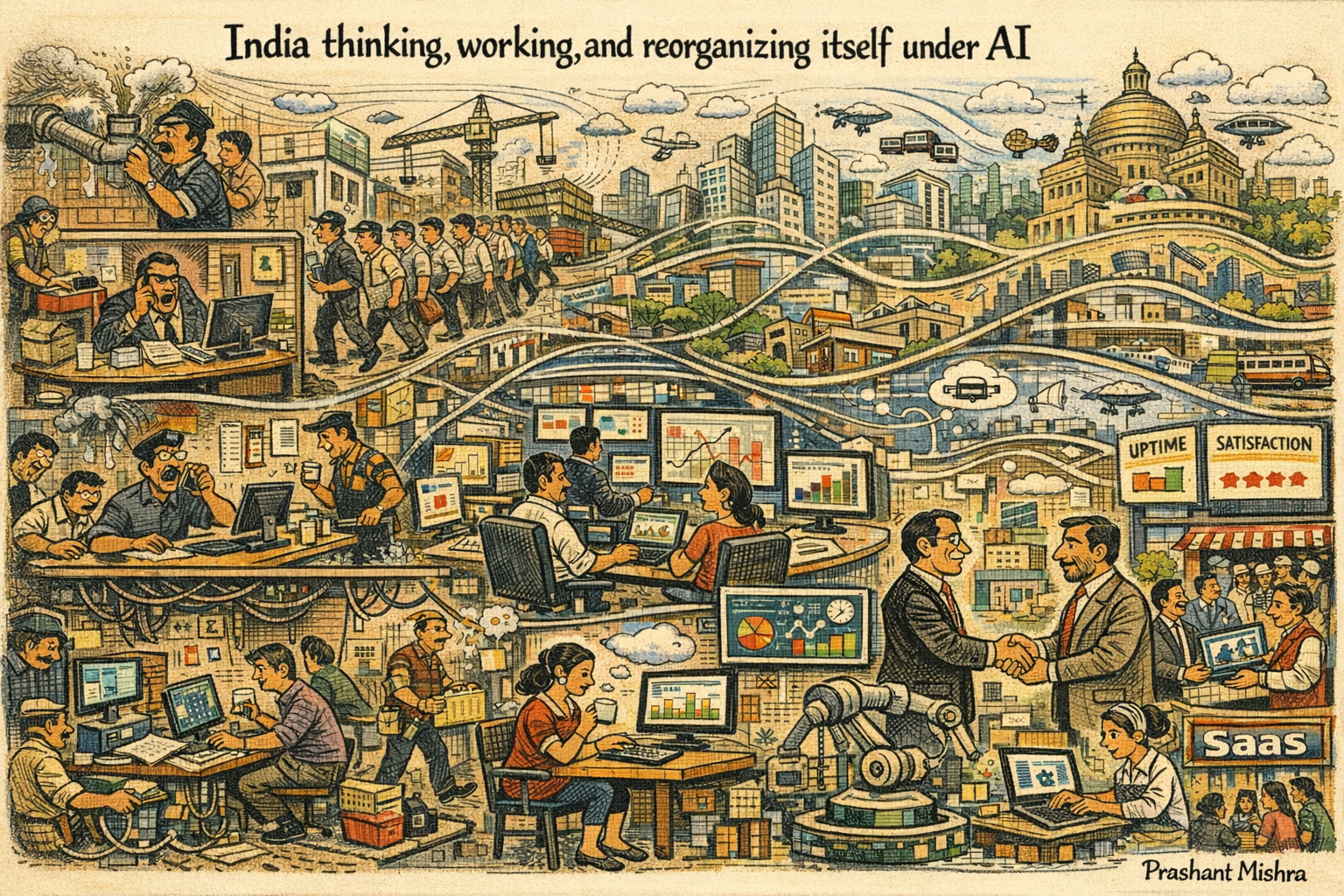
Complexity Science and the Art of Organizational Management
American businessman and author Aaron Dignan made a profound yet counterintuitive observation: “Every five-year plan, every annual budget, and every fixed target is a public confession that we don’t understand the nature of our organization. Our desire to control blinds us from the truth." Aaron is not only talking about organization, management, and the future of work, but perhaps about society at large.
All organizations are complex systems. This is easily deducible since all biological, psychological, and social systems are complex, and organizations being comprised of humans who are constantly engaged and working to deliver sustainable value to stakeholders should obviously be complex as well. Thus, by accepting an organization as a complex system, we can embrace the possibility of encountering surprises and uncertainties that require resolution. A complicated system can have a "solution,” but a complex system can only have a management strategy that can be used to influence towards a desired state. Therefore, when viewed through this perspective, leadership transforms into the establishment of a supportive environment where employees can flourish and strive to fulfil the organization's values, objectives, and mission.
But while this seems straightforward, most leaders continue to operate under the assumption that their organization is a “well-oiled machine” rather than a living system. Under this relentless pursuit of mechanization, leaders throw resources—time, human capital, technology, money, etc.—in the hope of controlling the future and future outcomes. Influenced by this disastrous mechanistic view, leaders attempt to control employee behaviors and decisions through the implementation of stringent processes, complicated bureaucracies, strict rules, and industrial-age policies. And yet research proves that they fail miserably because all this does not deliver the desired outcomes. Instead, it delivers low productivity, time waste, suboptimal operations, minimal innovation, and employee disengagement and apathy.
Leaders who approach organizations not as command-and-control machines but rather as a complex system understand that detailed set-in-stone business planning, carrot-and-stick policies, tight, meticulous rules, etc. will yield little to no result in this new age. Perhaps in the beginning, such approaches may yield some results and promise increased productivity, but over time, these returns diminish and eventually the well dries up.
Organizations are a classic example of a non-linear system in which minor events can have grave consequences and sometimes even large initiatives can have minimal effect. For instance, Kodak, despite its own innovation in digital photography, failed to recognize its potential. This single act led to the eventual bankruptcy of the company. An excellent illustration of how organizations are fundamentally non-linear systems is the rapid emergence of employee groups within the organization. These are the classic lunch groups, sport groups, or weekend getaway groups that employees form. Regardless of the tightness of organizational silos, the regimental culture, or the structure of the organization, the emergence of these informal groups primarily stems from human nature's inclination to form social bonds. Despite receiving minimal attention, these groups coexist alongside the formal organizational structure. What is even more intriguing is that these so-called informal and small groups consolidate and wield far more clout than formal organizational functions such as HR, compliance, sales, etc. They lack formal leaders, instead relying on independent agents who adhere to simple rules. Removal of an agent (for example, resignation of an employee) does not destroy the group, thus demonstrating resilience and robustness. All these are classic characteristics of complex systems. These groups not only transmit information, but they also thrive on it. They can form silent resistance or silent support for objectives, thus galvanizing the organization.
Applying complexity science techniques enables leaders to take a step back and view the organization as a complex system. This enables them to establish the most favourable circumstances where employees strive for excellence and, consequently, accomplish the objectives of the organization. It encourages the establishment of a flexible and innovative environment that promotes constant adaptability, resilience, and superior performance. In order to exploit the complex qualities of organizations, the first step is to revisit their structure, both formal and informal, while appreciating the fact that collective intelligence, culture, and self-regulation among employees are the active ingredients that deliver results and improve performance. Therefore, we should aim to identify organizational behavior patterns that can result in specific outcomes or collective actions, rather than focusing on causes that may lead to alienation or blame games. By focusing on patterns instead of rigidly adhering to procedures, structures, and organizational rigidity, complexity science can assist leaders in optimizing any situation. After resolving the organizational structure issue, complexity science can assist in managing employee behaviour.
How a company approaches, analyzes, and handles problems and challenges is dependent on the degree of freedom its employees largely enjoy and the acceptable behaviour expected from them. Therefore, encouraging autonomy and maximum freedom within the ambit of “Accountability” is the key. As previously mentioned, complex systems are composed of constituent elements that operate independently yet adhere to simple rules of engagement. It is this feature that allows them to constantly adapt to changing conditions. Similarly, in organizations, groups in general and employees in particular that enjoy autonomy tend to organize themselves in ways that ensure that they work together most effectively. This usually occurs after multiple iterations of their functioning styles, similar to how a complex system constantly adjusts its structure to find the most optimal one for its survival. This also draws parallels with the Complexity Science concept of fragments. Fractals are geometrical patterns that repeat themselves on various scales. Structures such as shorelines, mountain ranges, cloud patterns, and tree structures exhibit these fractals in nature. Organizations, too, can mimic the idea of fractals by first ordering themselves in the most optimal organizational structure. Then, by repeating this pattern at various scales, organizations can self-replicate it, leading to increased complexity and a more efficient design.
Such an approach to organizational design can be very helpful in today’s volatile business environment, in which companies need to constantly restructure as markets expand or collapse, consumer patterns change, and technology evolves at breakneck speed. Numerous examples now exist of organizations that had once succeeded by employing “non-adaptive” controlling structures but eventually failed as the industrial age gave way to information and later the digital age. Complexity Science proves that self-correcting, self-organizing autonomous systems that can adapt, evolve, and grow with free will as long as they follow simple rules of engagement are the most likely to survive the turbulence of the new age. The 20th century was the glorious epilogue of the industrial age that emphasized and rewarded repetition, precision, goal-focused structure, and mass assembly line manufacturing approaches. Consequently, these "machines" gave rise to management tenets that prioritized performance over human emotions and aspirations. The information age, the digital age, and now the age of AI all have been reading the riot act to every such arcane management approaches. This is an era characterized by constant unpredictability, where the need to integrate human values and economics is increasing exponentially. Such a situation cannot be managed by rules that operate on linear cartesian models that focus on employing reductionism to either “fix” the problem or “find” a permanent solution. There are no permanent solutions, and nothing remains fixed. Thus, leadership must transform into a non-linear, system-thinking-based approach that views the situation as a "whole," rather than a collection of sub-components. Such a systems-thinking approach fosters control, fosters the emergence of strong values, encourages open communication, and gently enforces accountability.
Chaos Theory and Complexity Science both provide powerful mediums to tackle the dynamic evolution of markets, industries, and economics. In complex environments, prediction is impossible and constant change is inevitable. As a result, resilience, robustness, and adaptability are essential for survival and progress. We can devise management strategies that do not force control on organizations, societies, and communities, but instead coax them towards desired outcomes by visualizing them as complex systems. The management mindset must migrate from the "complicated,” which uses reductionism to address issues, to the "complex,” which views the system as a whole. This shift in mindset is the most challenging task, as we have grown accustomed to our old ways of functioning. But this change is inevitable. Leaders that cling to the comfort of the command-and-control mechanisms, those that shun ambiguity or uncertainty, and those that hate surprises will find it increasingly challenging to survive and remain relevant. This will limit their trajectory and stunt their growth. However, leaders who embrace ideas for their own sake and adopt a system-thinking approach will succeed. Those that gracefully accept that they may not be able to control everything and that complexity is the key and that dynamic non-linear connectedness is the rule of the new game will hit the jackpot. They will not only excel but also achieve remarkable relief from the stress of trying to control the uncontrollable. Such leaders will nurture their humanity, learn and adapt constantly, build mutually beneficial relationships, and they will eventually foster a sense of purpose in their organization and community.


